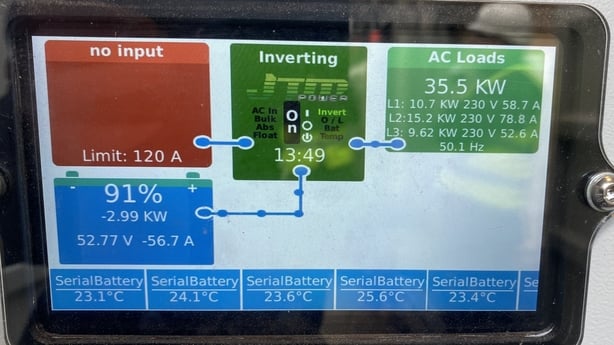A Dublin building site has been benefitting from the installation of batteries charged by generators to save on electricity use and reduce reliance on fossil fuels.
Building sites need a lot of electricity. There are the cranes lifting heavy loads, the drying rooms, toilet blocks and offices for the workers as well as lighting and security cameras.
It can be too much demand for the local mains electricity supply, so most sites generate their own electricity, mostly using diesel generators.
This can be very inefficient as generators are set up to provide enough power to meet peak demand. That could be when a crane motor starts to turn as it goes to lift a load.
Within seconds that demand falls and most of the time the power needed is far less than what is available.
Sustainability lead with Clancy Construction Tom O'Malley has been working at a construction site in Stillorgan, for social housing and a library for Dún Laoghaire/Rathdown County Council.
He said the site is set up with three generators.
"Three generators working for ten hours a day, and they're always idle, so always burning fuel, whether the cranes or the site accommodation is sucking the fuel, sucking energy, or whether it's not sucking energy - that what’s the generators will do," he said.
This type of set up has been compared to running a car engine to charge a mobile phone.
Aware that generators accounted for a large chunk of their fuel consumption Clancy Construction went to Wicklow-based company JTM Energy.
They have provided a set up where one generator charges a 160kva battery, which can store 240kwh of energy. The battery is supplying all the electricity needed to the site.

The sole generator has been running for five hours a day to charge the battery, a big saving on running three for ten hours daily.
Frank Daly of JTM Energy said: "This is the first site that we know of, either here in Ireland or across the UK, that has run an entire site on a battery. So what we're doing here is that the whole site is run from this battery, but the generator is topping it up with power".
He said the savings are made because the traditional set up is an inefficient use of a generator.
"A generator likes to be loaded. The analogy I always use is: does your car prefer to be stuck in traffic in Dublin, or does it prefer to be in cruise control on the M50? Obviously it would prefer to be in cruise control. A generator that is poorly loaded is like the car in traffic.
"What we do is we just use the generator to charge the battery. So there's always a good load for the generator.
"It's now running at its optimum efficiency because it's properly loaded, but we turn it off when the battery is charged".
The large battery and control system needed to use it with the generator was a substantial investment for Clancy Construction.
Mr O'Malley estimates it will take years to pay for itself.
"It’s around a three-and-a-half-year return on investment. We do need to put it on other sites, in the future. This site is probably another 12 months, but effectively, that's the same as any piece of plant and equipment we have across the business, so we will use it. It's robust and it will be used in other sites."
Dún Laoghaire/Rathdown County Council contributed to the investment.

County Architect Andrée Dargan said it is part of a commitment to climate action.
"We actually looked at it from our energy support budget. The council is very much interested in climate action, both our elected members and our executive, it's one of the priorities for the Council. So we're always looking at innovative ways, and we have been involved in supporting other companies to try out new products".
Mr Daly said batteries can be used in any context where electricity is needed "at present, we're doing a lot on off grid, particularly in construction sites, but there are applications for on grid.
"Any business, or any home with a meter could use a battery, and what it provides them with is grid resilience in the event of an outage due to a storm like we had a few weeks ago.
"You can also use it to play the market and avail of cheaper electricity at night or during times of low demand. And you can use it to increase the yield that you might have from renewable energy, like the solar PV on the roof."
Ms Dargan said batteries could be an alternative to generators at outdoor events or markets, and that there are other benefits apart from the emissions reductions.
"It reduces the pollutants in the air, reduces the noise and all that. It's beneficial for the workers here on site. You can hear the site is quite quiet, and also is obviously beneficial for the residents who live nearby and the wider area, obviously for the planet."








